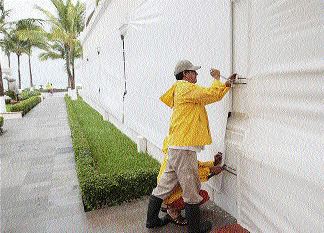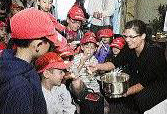Down but far from out, Mexican tourism industry heads into all-important winter season
Andrew McCredie
Sun

The variety of activities available for visitors to Mexico is endless. The country has become a favourite stopping point for honeymooners or couples who are trying to get away from it all.

Mexican beaches are perfect for losing the cares of the world and revitalizing yourself in preparation for visiting the country’s other sites. The colonial architecture of the city of Oaxaca is also a major draw with camera-ready tourists. CNS FILE PHOTOS


The combination fishing village and beach resort of Zihuatanejo provides a taste of the real Mexico along with the amenities of a high-end resort. CNS FILE PHOTOS

Quesadillas are available here, but there’s nothing like the real thing

Few stretches of waterfront anywhere in the world equal the Mayan Riviera

Archeological sites feature pyramids, caves, lost cities and sacred bogs
Premier Gordon Campbell would do well to headhunt a public relations person or two from Tourism Mexico.
After all, can there be anyone who has suffered the slings and arrows of misfortune more in the past year than the Latin American country’s tourism industry?
The industry’s struggles make the Liberals’ ballooning deficit and deflating approval rating issues seem pretty tame by comparison. First, a worldwide economic downturn of unprecedented scope decimated the number of international travellers visiting the country; then a tiny Mexican village became ground zero for a swine flu pandemic; and now hurricanes and all-around nasty weather batters its Pacific coastline.
Once the skies clear, just as they have for centuries, the Mexican people will rebuild and come back better and stronger than ever.
As the industry heads into an all-important winter season, an improving global economic outlook should help their effort, as should airfare/accommodation deals too good for Canadian travellers to pass up.
If that’s not enough, here’s a list from A to Z of what the country has to offer.
Archeology
Get in touch with your inner Indiana Jones at any number of archeological sites, featuring pyramids, caves, lost cities and sacred sacrificial bogs. Catch one of the ancient wonders of the New World at Chichen Itza, especially during the spring or fall equinoxes when the sun’s light creates a slithering serpent descending the Temple of Kukulkan. Simply otherworldly.
Beaches
Of course, reading about ancient civilizations is almost as good as being there, and there’s no better place to soak up some scholarship and the sun than a Mexican beach. My personal favourites run along the Pacific Ocean, as surf big and small is never far away, and there’s nothing like falling asleep to the sound of rolling waves.
Cancun/Cabo
The bona fide Spring Break capitals of Mexico — if not the world — the double shot of Cancun and Cabo San Lucas is party central from January through May. Tens of thousands of college students descend on the beaches and bars of these built-to-party resorts to blow off semester stresses. Be afraid. Be very afraid.
Diego Rivera
Just as the Group of Seven’s stark, desolate style defines the Canadian experience, Diego Rivera’s paintings define Mexico’s. Much of his great works are found throughout the world’s top museums and galleries, however, Mexico City’s Museo Dolores Olmedo is home to a treasured Rivera collection and one well worth a visit.
Ecotourism
Sure it’s a rather contrived buzzword, but ecotourism is a vibrant part of Mexico’s tourism business, and judging from the ever-increasing number of operators going green, it isn’t going away any time soon. One of the best tours is the Sian Ka’an Biosphere, located on the Mayan Riviera in the largest protected area in the Mexican Caribbean.
Festivals/fiestas
If there’s one thing Mexicans love to do it is party, and the nation’s calendar is littered with fiestas. Festivals large and small take place throughout the year and throughout the country. You’ve still got time to book a flight to Mexico City to catch El Día de los Muertos, the spooky Day of the Dead festival, on Nov. 2 in the city’s Mixquic suburb. Once a village in its own right, it retains its rural roots and its Day of the Dead celebration is said to be one of the most colourful.
Golf
The game of golf’s global explosion the past two decades has left an indelible imprint on Mexico, with some 150 courses scattered throughout the country. For a memorable golf holiday, check out El Tamarindo Beach & Golf Resort, located between Manzanillo and Puerto Vallarta in a 2,040-acre nature preserve. The thing about this luxury resort is even if you don’t golf, you’ll be blown away by the lush and undeveloped setting.
H1N1
Taking a page or two from Tourism Canada’s playbook following the SARS outbreak of 2003, Mexico has been on full damage control since spring, when the so-called swine flu devastated the all-important tourism business. The upshot? Great deals for Canadian travellers. And wash your hands.
Isla Mujeres
Located a dozen kilometres from the party capital of Mexico, this tranquil island couldn’t be more different from the nearby Spring Break Mecca of Cancun. Just seven kilometres long and 650 metres wide, Isla Mujeres is a great place to chill out for a day or totally unwind for a week.
Jalapeño
The little chili that launched a million heartburns is cultivated in a number of places in Mexico, but the Papaloapan River basin is where it was traditionally produced by the townspeople of Xalapa.
Kissing
Latin American countries are renowned for their homegrown lovers, but its not difficult for visitors to Mexico to find a little love in the air. Long a honeymoon destination, the country is ripe for romance.
Lime
What is it about putting a lime in a pint that makes even a rainy night in a Vancouver lounge seem a little bit of Mexico? Nearly 15 per cent of the world’s limes come from Mexico, and with the fruit growing virtually everywhere in the country.
Mayan Riviera
Few stretches of waterfront anywhere in the world offer the diverse range of experiences that this 132-kilometre tourist corridor does. There are Mayan ruins in Tulum at one end, at the other a Hooters restaurant in Cancun; there are all-inclusive luxury resorts just minutes from the quaint seaside town of Playa del Carmen; and there are five-star restaurants where a dinner jacket is required and beachside stands that serve you barefoot.
National Palace
Built more than a century before the Palace of Versailles, the National Palace in Mexico City sits on a site that has served as the seat of power since the Aztec Empire. Fittingly, the main stairwell mural painted by Diego Rivera is entitled The Epic of the Mexican People.
Oaxaca
The Free and Sovereign State of Oaxaca has more than 250 kilometres of accessible beaches, but it’s the colonial architecture in the capital city of Oaxaca that brings camera-toting tourists to this Pacific Coast state by the planeload.
Pesos
With the loonie translating to roughly 12 pesos currently, coupled with the fact the country’s reeling tourist industry has slashed prices across the board, there’s plenty of value for the Canadian dollar.
Quesadillas
There’s not a Vancouver tap house worth its salsa that doesn’t have this Mexican dish on the menu, but as the old saying goes, “Ain’t nothing like the real thing, amigo.” Best one I ever had was at an outdoor restaurant in the busy town centre of Manzanillo.
Riviera Nayarit
Located just north of Puerto Vallarta on the Pacific Coast, this new luxury resort community has quickly, and somewhat quietly, become the place to play golf in Mexico. No fewer than six championship courses are within an hour’s drive of one another, and later this month the Jack Nicklaus-designed Punta Mita Pacifico course hosts a Canadian Professional Golf Tour event, the Riviera Nayarit Classic.
Scuba/surfing
From the world-class diving sites off Cozumel to the Pacific Ocean swells off Puerto Escondido, Mexico is heaven for those who like to dive below the waves and those who like to ride them. Most resorts offer scuba certification courses for beginners, while surf schools can be found up and down the Pacific coastline.
Tourism
As integral to Mexico’s economy as natural resources are to Canada’s, international tourism to the country has taken a battering the past year for reasons it can’t control. But with more than one out of every 10 Mexican employed directly in the industry, the country is pouring resources into promoting itself around the world.
UNESCO
Mexico ranks first in the Americas and eighth in the world for the number of sites recognized in recent years by the United Nations Educational, Scientific and Cultural Organization. No fewer than 26 sites have UNESCO endorsement for their historical, cultural and natural significance.
Veracruz
Home to the highest point in Mexico — the 5,363-metre volcano Citaltépetl — the State of Veracruz is also home to the oldest still-standing Catholic chapel built in the Americas (in the village of La Antigua).
Whale watching
The Pacific Ocean off Mexico is a major whale highway, and an increasing number of tour operators are providing opportunities for tourists get close to these creatures. Mid-December to March is prime whale watching season, and with some tour operators using spotter planes to locate the massive marine mammals, your chances are good.
Xcaret Eco Park
Imagine if Walt Disney built a Mayan ecological theme park and you’ll have some idea what this place is all about. Featuring the flora and fauna of the Mexican southeast, including sea turtles, manatees and spider monkeys, the main attraction is a massive water park that lets you swim with dolphins and other marine life. Great for families.
Yucatan peninsula
Rich in history and culture, the Yucatan peninsula was home to the ancient Maya and boasts two of the greatest archeological sites in all of Mexico — Chichen Itza and Tulum.
Zihuatanejo
This laid-back Pacific Coast community is part fishing village, part beach resort and is the ideal place to recharge for a week or so. For a great dining experience, check out Coconuts. And if the urge strikes for some Jell-O shooters and techno, the bright lights of Ixtapa are just a cab ride away.
© Copyright (c) The Vancouver Sun







